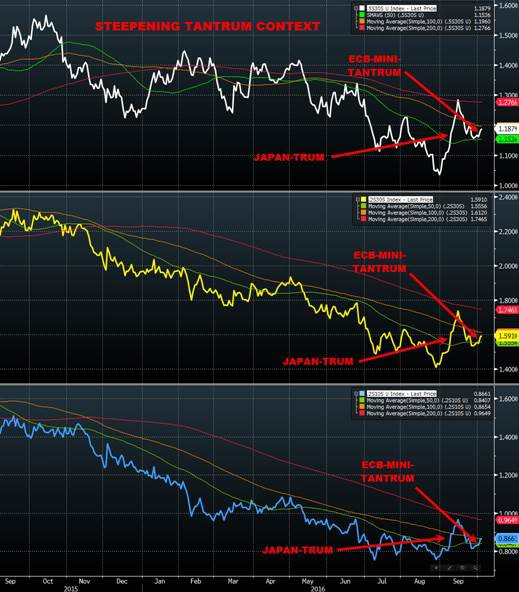"Heaven Help Us If There Is Ever A Modest Blip Of An Inflation Impulse"
Charlie McElligott
 Despite the weakest Euro area Composite PMI since January ’15, periphery and core EGB’s are too seeing weakness, with traders noting not just the “tapering” story, but also Target 2 balance data, which is showing Italian and Spanish liabilities at 3+ year highs against German claims (2nd highest reading since 2008). All-in-all, just the hypothetical mention of “tapering” speaks to the extent of speculative positioning in the periphery govies, with the seemingly lazy 3-day move lower in IKA (Italian BTP futures) actually being a 2.1 standard deviation event (against the returns of the past year). To my points made for years now on risk-parity, risk-control / vol-targeting and leveraged ETPs, it’s the cost of “shadow short convexity” in the market place (as the strategies increase or decrease their exposure based on CB-repressed historical volatility), which now “more frequently than ever” smashes asset prices with stiff jolts of volatility “true-ups,” on account of their mechanical and unemotional rebalancing (and after a couple days…“back to normal” we go, as if nothing happened--this is your market structure). Despite the weakest Euro area Composite PMI since January ’15, periphery and core EGB’s are too seeing weakness, with traders noting not just the “tapering” story, but also Target 2 balance data, which is showing Italian and Spanish liabilities at 3+ year highs against German claims (2nd highest reading since 2008). All-in-all, just the hypothetical mention of “tapering” speaks to the extent of speculative positioning in the periphery govies, with the seemingly lazy 3-day move lower in IKA (Italian BTP futures) actually being a 2.1 standard deviation event (against the returns of the past year). To my points made for years now on risk-parity, risk-control / vol-targeting and leveraged ETPs, it’s the cost of “shadow short convexity” in the market place (as the strategies increase or decrease their exposure based on CB-repressed historical volatility), which now “more frequently than ever” smashes asset prices with stiff jolts of volatility “true-ups,” on account of their mechanical and unemotional rebalancing (and after a couple days…“back to normal” we go, as if nothing happened--this is your market structure).
The BoJ kicked this party off in September with their “curve steepening” discussion (since put “into motion” under the guise of “curve control / yield targeting policy”). As I have stated since over a week before the BoJ meeting, any curve-steeping operation could in fact be interpreted by the market as a QE taper, because 1) the BoJ is then by definition buying fewer bonds past 10 years against buying more in the belly—despite running out of bonds to buy there (!), and 2) potentially in a position where to stay true to their new policy, the BoJ could turn a NET SELLER of bonds when 10Y yields turn more negative!!! As such, the global long-end sold off, triggering the aforementioned systematic fund de-leveraging which spilled-over across most every asset-class (except for US Investment Grade, which in the words of country-great Travis Tritt continues to act “10 feet tall and bullet-proof” -> How’s that for showing my Ohio roots).
This latest version emanating off the Bloomberg story got a bit too much “headline” action, where the story itself spoke to a likely extension of the current ECB bond-buying program before “running out of Bunds” come-March. The market is positioned for this extension / “perpetuation of the status-quo”…although they also were in September, when it never came up in the ECB meeting. All eyes consensually see it coming in December now, yet some folks we speak to (who are close to the situation) indicate that the ECB is very closely watching the BoJ and the “market interpretation” of their current “stall tactics” being exhibited (in the form of this “curve control” snowball, against their longer-term “NEED” to go further NIRP-ier…which requires consensus building domestically and abroad on account of the negative implications for banks, pensions, insurance and corp balance sheets / capex investment). Everybody is trying to buy-time…but at the end of the day, “extend and pretend” is the name of the game. FWIW, I personally believe this was a “shot across the bow” by Draghi to the ECB’s General Council (zee Germans) that “more needs to be done…free us from your shackles...or else you are gonna have blood on your hands.”
It is SO tired, but let’s face it: when even the limpest “trial balloon” discussion of the ECB’s hypothetical, WAY down-the-road discussion of how to end their QE program (we could be talking 2020 here people) creates yet another “Mini-Taper Tantrum,” we have to be intellectually honest with ourselves (as do CBers) and acknowledge the incredible degree to which the current monpol framework has distorted prices / valuations / market structure. All assets are hooked on stimulus, and yet CB’s refuse to take the pain of allowing actual price-discovery. A “winnowing-out” of the excess leverage and weak-handed lazy positioning would allow for a return to a greatly-desired / more-functional capital-market, and with it, the “business cycle,” which would benefit the real economy for the “greater good.”
Ultimately, this is another “crack in the façade” of the QE monpol regime, buckling-further under its own weight. In both the case of the BoJ and the ECB, they are acknowledging that they have little-choice but to move to “yield targeting” due to said curve and market distortions as again, both are running out of bonds to buy.
And with that, so too wanes the market’s believe in the omniscience of the current framework (although yes, CB’s without a doubt can still “escalate” via debt monetization / “helicopter money”…but nobody has yet shown resolve to go ‘nuclear’ without a true crisis), especially as their policies only further set-the-table for volatility explosions—as they force “real money” to get “even long-er” of duration through their yield compression madness. Heaven help us if there is ever a modest blip of an inflation impulse. Caveat emptor.
CONTEXT OF THE OVERSEAS IMPACT ON UST CURVES FROM ‘JAPAN-TRUM’ AND NEWEST ‘ECB-MINI-TANTRUM’:

Charlie McElligott is the head of cross-asset desk strategy at Royal Bank of Canada
 RBC Capital Markets is a premier investment bank that provides a focused set of products and services to corporations, institutional investors and governments around the world. With more than 6,950 professionals, we operate out of 70 offices in 15 countries across North America, the U.K., Europe, and the Asia-Pacific region. RBC Capital Markets is a premier investment bank that provides a focused set of products and services to corporations, institutional investors and governments around the world. With more than 6,950 professionals, we operate out of 70 offices in 15 countries across North America, the U.K., Europe, and the Asia-Pacific region.
We work with clients in over 100 countries around the globe to deliver the expertise and execution required to raise capital, access markets, mitigate risk and acquire or dispose of assets. According to Bloomberg and Dealogic, we are consistently ranked among the largest global investment banks.
Royal Bank of Canada
RBC Capital Markets is part of a leading provider of financial services, Royal Bank of Canada (RBC). Operating since 1869, RBC is one of the top 15 largest banks in the world and the fifth largest in North America, as measured by market capitalisation. With a strong capital base and consistent financial performance, RBC is among a small group of highly rated global banks.
www.rbccm.com
|




